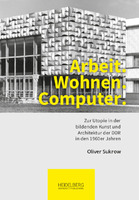Arbeit. Wohnen. Computer
Double-Blind-Peer-Review overseen by Publisher
Zur Utopie in der bildenden Kunst und Architektur der DDR in den 1960er Jahren
Author(s)
Sukrow, Oliver
Collection
AG UniversitätsverlageLanguage
GermanAbstract
In the 1960s, between the construction of the Berlin Wall (1961) and the change of power (Ulbricht / Honecker 1971), a field of tension between the claim to power and truth of the SED on one side and the subjective obstinacy of the works of art and their creators on the other hand developed. Within it, debates arose regarding the question of the design and appearance of a future, technologically high developed and scientific socialism. Working. Living. Computer tracks down questions about the appearance of the worker of the future, the future of living, and the significance of the computer in the future and analyses these imaginative worlds of socialist dreams and desires in image, architecture, and texts. Im Spannungsfeld zwischen Macht- und Wahrheitsanspruch der SED und dem subjektiven Eigensinn der Kunstwerke und ihrer SchöpferInnen entfalteten sich in den 1960er Jahren zwischen Mauerbau (1961) und Machtwechsel (Ulbricht / Honecker 1971) Debatten um die Frage nach Gestaltung und Erscheinungsbild eines zukünftigen, technologisch hoch entwickelten und wissenschaftlich fundierten Sozialismus. Arbeit. Wohnen. Computer. spürt anhand von Fragen nach dem Aussehen des Arbeiters der Zukunft, nach dem Wohnen der Zukunft sowie nach der Bedeutung des Computers in der Zukunft diesen Vorstellungswelten sozialistischer Wunschräume und Wunschzeiten in Bild, Bau und Wort nach.
Keywords
Architecture; GDR; Art; Utopia; Socialism; Architektur; DDR; Kunst; Utopie; SozialismusDOI
10.17885/heiup.422.613ISBN
9783947732098; 9783947732104OCN
1100539173Publisher
Heidelberg University Publishing (heiUP)Publisher website
https://heiup.uni-heidelberg.de/Publication date and place
Heidelberg, 2018Classification
Photography and photographs


 Download
Download